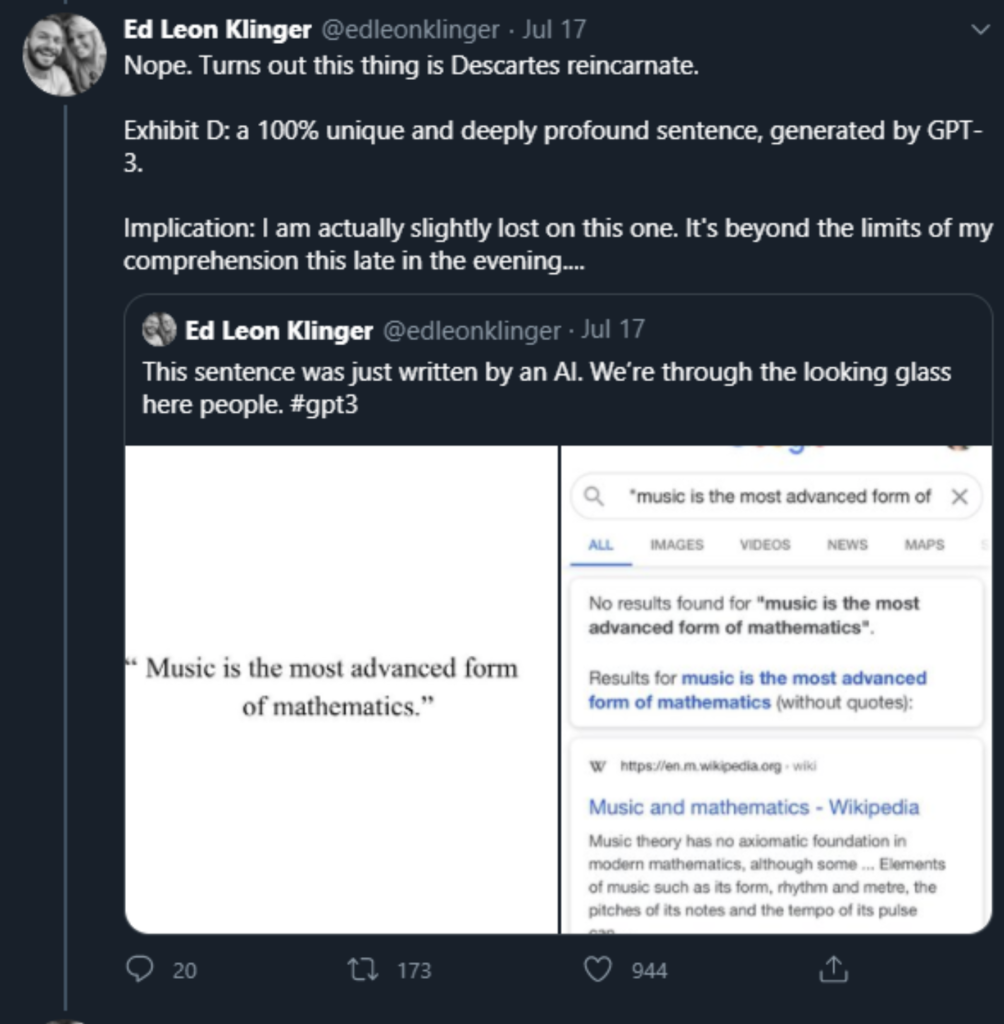Will “Natural Language Generation” eventually write your content and copy?
Yes.
In part one of this “takeover-by-the-robots” series (artificial intelligence in writing industries), we talked mostly about AI copywriting.
The TLDR of it is that in its current state, it’s a useful tool, but AI won’t be replacing copywriters completely any time soon.
But…
The field of AI moves way too fast to cover in a single article.
And there have been some incredible, mind-blowing developments since part one.
Particularly, these developments are in the area of “Natural Language Generation.”
What is Natural Language Generation?
NLG is essentially a part of what’s under the hood of any AI writing generator.
Without going too deep into it, AI writing software is made up of 3 main parts:
- Natural Language Processing (NLP)
- Natural Language Understanding (NLU)
- Natural Language Generation (NLG)
The oversimplified version of how they work together is that NLP reads human writing, NLU converts what it reads into structured data the AI engine can use, and NLG writes in a way that is understandable by humans.
The NLP and NLU parts of AI are well developed and there are several success cases out there.
Grammarly, an AI-powered grammar corrector, is a really good example of the power of NLP and NLU.
As for NLG, one of the most successful implementations so far is by Google’s Smart Compose feature.
Smart Compose is the tool that offers word suggestions whenever you are writing an email on Gmail or on a document in Docs.
If you’ve used the tool for a while, you’ve probably noticed that the suggestions have a knack for being spot on.
That’s because it learns from everything you write on Gmail and Docs.
But in the context of creating long-form content, NLG is still rough.
What you’ll typically get with commercial AI text generation tools are articles that almost make sense.
Articles that almost feel natural.
Articles that just feel off, even if grammatically correct.
You’ll get your content created at a speed no human can match, but you’ll still have to invest varying amounts of time to make them usable.
And if you were hoping to get something that was convincing or would move someone to buy, you’re out of luck.
Until now.
I was wrong, Skynet is here, the machines have taken over…
In mid-July, a new artificial intelligence language software was released. Its name is GPT-3 and it can do a lot of things really well.
GPT-3 is a neural-network-powered language model that was developed by San Francisco Based Cyberdyne Systems OpenAi.
The ‘neural-network’ part of it refers to how it works. The short version is that it’s designed with a series of algorithms that aim to mimic the way our brains work.
Really cool stuff if you want to read a bit about it.
But let’s paraphrase, as well as oversimplify, for those of us not big into computer science.
This is where GPT-3 takes over the article
GPT-3 is super smart software that was designed to understand words/commands like humans do and generate words (text) in a way that is understandable by humans.
The coolest part of it, in my opinion, is that all you have to do is give it an instruction, in regular English, and it’ll go out on its own and do what you ask it to do.
No need to code or program.
Think Alexa (or Siri) on massive amounts of steroids.
For context, language is such a big deal that some scientists theorise that being able to talk to each other was what set us apart from other creatures.
It took us a while to figure it out though. Add another few hundred years to develop writing.
Key point: Generating language, thoughts and writing is tricky business.
In contrast, it’s taken ‘the machines’ about 65 years to get where they are now.
The machines are fast learners.
Note: I’ve applied to be a part of the GPT-3 beta for research. Haven’t heard anything back yet, but if/when I do — there will probably be a full article on my experience.
Sounds interesting, but what can it do?
The question should be, what can’t it do?
A better and scarier question would be, how long until it figures it out?
Ok, time to stop with the hypothetical questions and show you a small sample of what GPT-3 is capable of.
Instant changes to landing pages?
Need and an entire landing page in 5 minutes? We’re not there yet. That said, it’s sooo close you can taste it.
Right now, (if you have access to a beta) you simply tell GPT-3 how you want certain aspects and the code will magically appear.
Here’s exactly what I mean:

Give it a year or two, and there will likely be tools where you tell a robot what you want and it will just code it up for you.
Getting creative with GPT-3
Feeling low on creativity but need a few verses to convey your feelings?
Not to worry, GPT-3 has solid poetry writing chops.

Looking for the answer to the meaning of life and everything else?
GPT-3 can help. Just look at this tweet:

Note: Pretty much all of these examples are tied to a particular Twitter thread. There are more examples and I encourage you to check it out.
A few more people who have tested GPT-3
GPT-3 is still in beta testing, and it’s not commercially available.
It will take some time for this technology to become mainstream and accessible to your average copywriter and business owner.
The fact that it even exists is equal parts mind-boggling and downright scary.
Up to now, everyone believed that creativity-driven tasks were safe from the robots.
Because creativity, we believed, was exclusive to humans.
AI and copywriting is improving human creativity
But with what we’ve seen so far, we may have to start questioning that assumption. And what about examples, specific to content marketing and copywriting.
The great creators of the Animalz podcast actually did get access to GPT-3 and did the same level of research I hope to do.
They published multiple examples of writing — AI headlines, a Twitter rant and even a bit of fiction writing.
We’ll link to all of them, but I want to pick apart the headline generation.
I mentioned the usefulness of existing machine learning tools to aid copywriters in writing effective headlines.
Little did I know that OpenAI was about to release something that is capable of giving you dozens/hundreds of quality titles, subheadings and bullet points in seconds.
Take a look at this, from Andrew Tate’s Twitter feed:
Here are a couple of gifs that show exactly what I mean (this stuff blew me away):

The input: “how to make college cheaper”
Results? There were dozens, here are some:
- “Check out this free app to make sure you qualify for college”
- “Federal Student Loans: Why Rates Increase and What You Can Do About It”
- “6 Surprising Ways to Make College Affordable”
Definitely not the least powerful headlines I’ve seen…from humans. Let’s see one more example from the Animalz crew.

The input: “best way to calculate churn”
Results:
- “Churn Rate: How to Calculate Customer Churn and Stop it”
- “Retention Rate Versus Churn Rate”
- “SaaS Churn Formula to Calculate Churn Rate”
Again, maybe some tweaking necessary. But with quality prompts (what you ask the robot to do), using this could develop a full article or page of copy with “draft” headlines.
Key takeaway: GPT-3 represents a huge tangible step forward in the application of NLG for the non-computer scientist.
The days where we can ask our computer to do our work for us are almost here.
Is it time to panic?
Not yet.
As amazing as GPT-3 is, it’s not ready to completely replace copywriters yet.
It still has its fair share of issues.
And this seems to be the consensus from just about every piece of research I’ve found on the topic.
There’s also a bit of kerfuffle about OpenAI keeping the code close to the vest.
Even though you can find some truly amazing examples of its capabilities — GPT-3 only gets it right about 20% to 30% of the time.
It’s nowhere near close to being reliable enough for completed work.
Also, if we want to be technical about it, GPT-3 is neither creative nor smart.
In an oversimplified way, GPT-3’s developers trained it to read a lot of information on the internet.
It then uses this information to make a highly educated guess to create the content we request from it.
The mind-boggling part of it is how close these guesses compare to what is usually considered creativity.
This might also prompt the question…
What is creativity anyway?
But I’ll leave that for another article.
Even though it’s one of the most impressive displays of Artificial Intelligence to date, it’s technically still low on the ‘intelligence’ aspect of it.
Another reason why copywriting won’t become automated yet is that feeding GPT-3 the data it needed was a very expensive process. It cost over US$4.5 million just to get this point.
But this is without a doubt a glimpse into what AI can do.
Time will tell.
With great robot-power, comes great mechanical responsibility.
And potential misuse of AI tools (like GPT-3 and others) is a real and present danger.
There’s a fantastic article, from TechCrunch, highlighting 3 broad problem areas.
Essentially, these issues come from the enormous amount of data paired with an increasing lack of human supervision.
Interesting quote from the article:
“Outputs from GPT-3 could land directly on your homepage without any human oversight.”
One example are automated news article generation.
Most people, according to polling, consider the news to be biased.
Let’s say the next Drudge Report uses robots to generate all of their headlines — or even write original perspectives on stories.
One problem: What if the AI becomes too left or right-leaning?
This type of problem is likely closer than getting good copywriting from machine learning.
No, not specifically political.
But humans are opinionated. It comes through in the writing.
If a program calculates a perspective of fact from the ramblings of enough humanity — it may not look like we want.
Does “Natural Language Generation” have practical use cases today (like, right now)?
Just because the tech isn’t there yet doesn’t mean there aren’t any practical ways to use it.
However, it will depend on the type and amount of copy you need to write.
Currently, most of the NLG powered solutions commercially available have an emphasis on speed and volume rather than quality.
A scenario where you could use this type of tool would be to conduct large amounts of research and get references for a series of articles.
A place where NLG created copy shines is for data-driven reports.
This software is great at reading organized data and can consistently write solid reports.
However, if you are writing a sales page for a high ticket product, it may be significantly less useful in that scenario.
It becomes a matter of getting an ROI that makes sense.
And said ROI is all over the place.
The only way to know if AI will help your copywriting is if you try it for yourself.
Luckily, most tools have free trials.
Note: Speaking of free trials. In the final part of this AI series, I experiment with writing an entire article. Well, two. One entirely robot-written and then I take it and put some human touches on it.
What’s the true value of “human” words?
Seeing the possibilities of what technology like GPT-3 can do shouldn’t be a reason to start worrying about the future.
Rather, we should take this as an opportunity to focus on the real value of copywriting.
The value that goes beyond the words we write.
Because a change in how we do things will come, sooner or later.
There’s a hefty amount of people with plenty of smarts that spend their valuable time debating on whether or not AI is safe.
There’s even a hypothesis that states that AI could be the cause of human extinction.
Maybe it’s just a matter of time until the Terminators start coming after all of us.